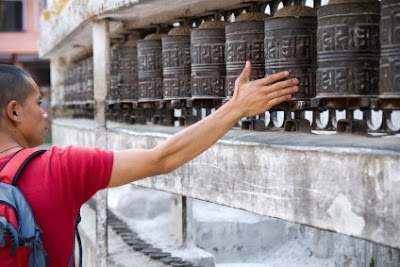Wesak is the most important day in the Buddhist calendar and is celebrated in May. Also known as Vesak or Buddha Day, Wesak celebrates the birthday, enlightenment and death of Buddha. It is held the day of the first full moon in May. On this day, Buddhists celebrate Buddha’s teachings and remember his insights about death, karma, rebirth, and suffering. Wesak is a celebration of joy and color. Buddhists clean and decorate their homes and begin to celebrate before dawn. Water is poured over Buddha statues and offerings are made to Buddhist monks and temples. Temples offer vegetarian food, lectures and candlelit processions. Learn more about this special holiday, and share these interesting activity ideas with your Montessori students.
Buddha Day / Wesak Culture Curriculum Activities in the Montessori Classroom
Buddhists of various countries have different ways of celebrating. For instance, dancing dragons are incorporated into Chinese celebrations, and lanterns made from wood and paper are used in Indonesia. In some countries, caged birds are released and in other countries origami cranes are floated down rivers. These customs symbolize releasing one’s troubles and wishing wellness and happiness for all beings.Activities for Incorporating Wesak in the Montessori Classroom
- Provide a simple story of the life of Buddha that teaches some of the basic tenets of Buddhism, and explore the parts of the world where Buddhism has a rich history.
- Making lanterns integrates art, geometry and cultural parts of the Montessori curriculum: www.buddhamind.info/leftside/actives/craft.htm. Folding origami cranes would also be appropriate.
- Students can create a global calendar that includes important dates from a variety of cultures. For example, Japanese Buddhists acknowledge the birth of Buddha on April 8th, Buddha’s enlightenment on December 8th and his death on February 15th. Other Buddhists use the lunar calendar to determine their observances.
- Older Montessori students might enjoy a comparative look at the lives of Buddha and Jesus Christ, or explore the life and teachings of today’s Dalai Lama.
- Buddhists give gifts during Wesak. They often give to the needy and will organize events such as blood drives. In this spirit, students could organize a food and clothing drive or perform a service in the community.
- Invite a Buddhist from the community to visit your Montessori classroom to share stories, photographs and artifacts. Alternatively, organize a class visit to a local Buddhist temple to explore and experience more about Buddhism.
- Listen to a CD of Buddhist chanting and explore the meaning and significance behind it.
- Explore symbols or art of Buddhism, such as prayer wheels, the wheel of life, or healing mandala.
- Buddha Day, by Jill Foran
- Wesak, by Anita Ganeri
- A Faith Like Mine, by Laura Buller
- A Life Like Mine, by DK Publishing
- My Buddhist Year, by Cath Senker
- The Usborne Book of World Religions, by Susan Meredith, Cheryl Evans, N. J. Hewetson, and Jeremy Gower
- The Story of Religion, by Betsy Maestro, Giulio Maestro, and Erika Weihs
- Buddhism, by Mel Thompson
- How I Celebrate, by Pam Robson
- Prince Siddhartha: The Story of Buddha, by Jonathan Landaw
- Children Just Like Me: Celebrations! by Anabel Kindersley and Barnabas Kindersley
- The Buddha: Young Seeker, by Paul Mantell
As much as possible, NAMC’s web blog reflects the Montessori curriculum as provided in its teacher training programs. We realize and respect that Montessori schools are unique and may vary their schedules and offerings in accordance with the needs of their individual communities. We hope that our readers will find our articles useful and inspiring as a contribution to the global Montessori community.
© North American Montessori Center - originally posted in its entirety at Montessori Teacher Training on Thursday, May 14, 2009.
© North American Montessori Center - originally posted in its entirety at Montessori Teacher Training on Thursday, May 14, 2009.



Good for you. Our children need to understand other people and their religious beliefs. This must be done in a way that it does not offend any one but it must be given to them. I am proud of you I wish more Montessorians throught like you and had the courage to teach world religions.Dr. Montessori would have done it in her time why not us?
ReplyDeleteI agree that Dr. Montessori would have done the same and we should too!
ReplyDeleteThanks for reading the blog. I really appreciate your kinds words.